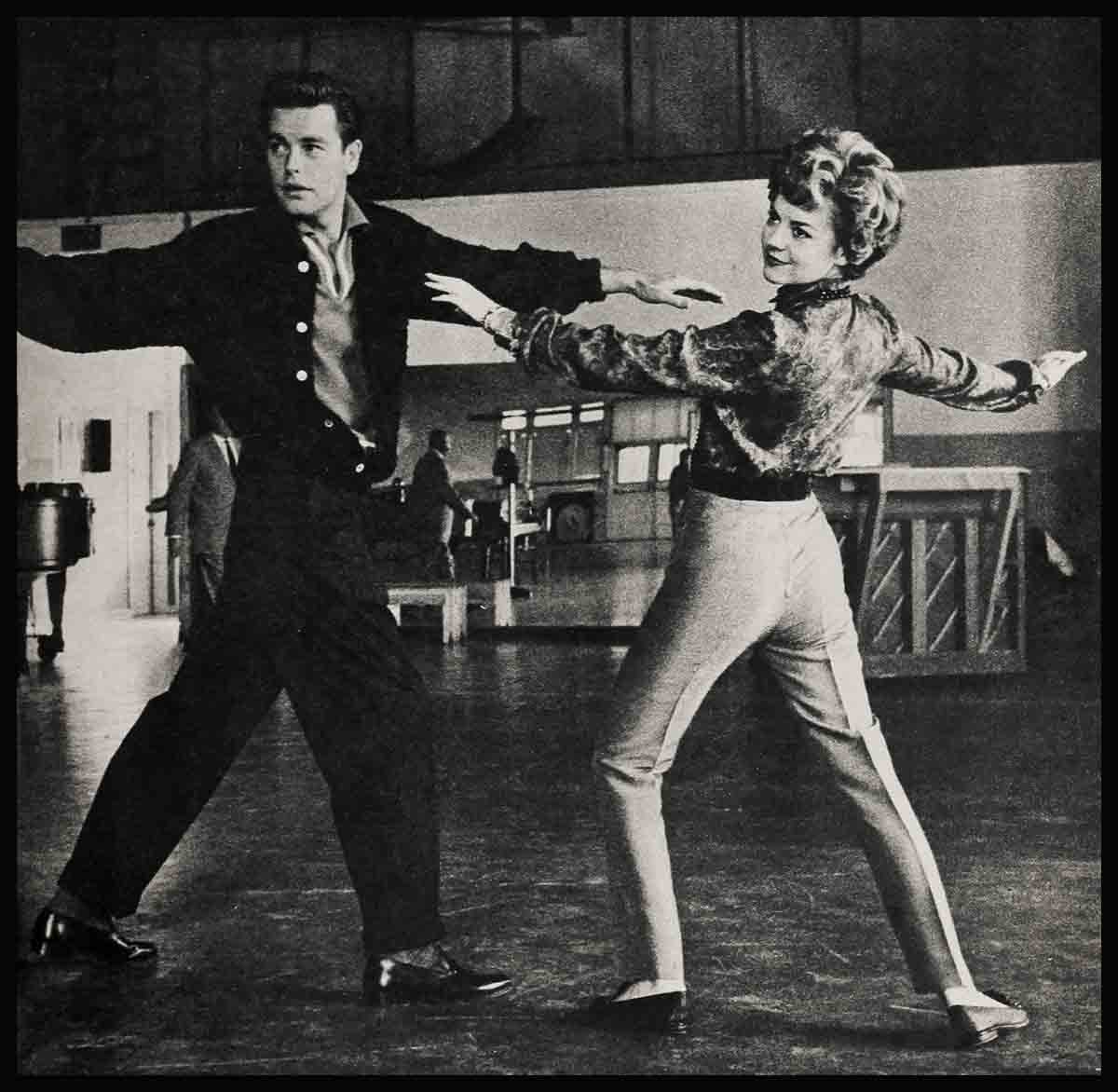
The Dream That Lasts A Lifetime
You say two magic words: “I do”—and immediately, you’re not just you, you’re half of a duet: wife, lover, friend, sweetheart, helpmate and keeper of the home. It’s a big responsibility, but it’s one that every girl dreams of, from the time she’s old enough to dream.
Vera Miles, who’s pictured here, was a bride herself last spring, when she became Mrs. Gordon Scott. Vera says, “I never eared much for personal belongings, but when it comes to the things that make a house a home, I’ve learned. Somehow, when you’re deep in the throes of some big emotion, you don’t want to think in terms of sheets and pillowcases and silverware and china and glass. That all seems too trivial. And yet, the minute you settle down to the everyday living of marriage, those are the things you spend your days with, and they get to be all important. I know.”
AUDIO BOOK
Vera, who jumped headlong into an early marriage at eighteen, after knowing the boy a month, was floored by the enormity of the job she’d undertaken. Her youth, spent living in Y’s and supporting herself since she was fourteen, hadn’t prepared her for the job of being a homemaker, and the day-to-day business of keeping house was difficult. For many reasons, her first marriage was never happy. Her second marriage, to Gordon Scott, has been different.
“When Pete and I (I guess I’ll never be | able to call him Gordon)—when we decided to get married, it may have seemed sudden, but we’d had a long time to get to know each other, and I’m glad of it. It gave our love a chance to simmer, a chance to develop, and for me to think things through and plan the kind of home we’d have.
“I must have been thinking of marriage unconsciously ever since I started my collection of fancy china about a year ago, and put it on a shelf in the kitchen that I called my ‘hope shelf.’ It got me started thinking in terms of making a home for Pete, of building something for us to share together.
“Isn’t it odd, I’ve always felt that here in America, where we teach our girls to be secretaries, actresses, teachers, file clerks and writers, we teach them almost nothing about the most important job of all: the business of making a home? My own little girls, Debbie and Kelly, will start early learning about the things that make a home. After all, a homemaker is what every girl wants most to be—so why not teach her as much as possible, as soon as possible?”
We think Vera’s thinking sound, and we agree. Whether you’re living at home, refurnishing a house that’s been under way awhile or, most happily of all, getting started as a Mrs. in a brand-new household of your own, you want to learn as much as you can about linens, sheets, towels, silver, glass and china, for they’re the little things which make a house a nicer place in which to live. And here are tips—some are Vera’s, some ours—to help you do it!
Set a Pretty Table: You’re lucky—you can be as new-fashioned as you please, and still be in the best of style. “My grandmother never saw a place mat in her life,” says Vera, “but I wouldn’t be without a set.” You, too, can have attractive, inexpensive place-settings for every day and choose them from among styles frilly as organdy or sturdy as plastic. And your tablecloth needn’t be white, as Grandmother’s most likely was. It can be almost any color of the rainbow, or something that even the rainbow hasn’t seen: a pastel sprinkled through with the glint of gold, for instance, or a vivid, bold plaid, or a print. You can have a tablecloth that’s been treated with a finish to make it stain-repellent, or you can have one that’s plastic-coated. And if you want it, you can have a beautiful cloth of light-as-air lace, woven of strong-as-steel Dacron. It’s all yours, for just the taking.
“In making a selection, however,” Vera reminded us as we spoke, “point out that the pattern in color and design should complement both the china and glass of the place setting and blend with the color scheme of the rest of your room.” Also be careful about the size too. For instance, if you choose one of the new oval tablecloths for an oval table, you won’t have horrible folds of a rectangular cloth gathering and hanging limply at the sides.
To test your table linen for quality—and the test is just about the only thing you’ll find hasn’t been improved upon: it’s the same one Grandmother used. Simply slip your fingernail under the seam of the hem. If the stitches are tiny and firmly placed, you’ll have a hard time penetrating, and the tablecloth will last longer than if the stitches are loosely placed and easy to get through.
Choosing Your China (and here’s a page right out of Vera’s scrapbook): Get re-acquainted with three good words, while you’re about the business of selecting your dishes. They are: porcelain earthenware and pottery, and they’re the three main groups into which dinnerware falls.
Porcelain (also called china) is made of highly-refined clays fired in a kiln at intense heat. You can see the shadow of your hand when you hold it to the light, hear a bell-like ring when you tap it with your finger.
Earthenware is fired at a lower temperature and for a shorter period of time. It must be glazed before you can use it.
Pottery is made of unrefined clays in their natural state and is less highly fired than earthenware. It’s heavier, non-transparent, and because it’s porous, it’s nonresistant.
In expense, the three groups rank roughly in the order given.
Select your dinnerware according to your taste, your plan for living and your pocketbook, “But by all means choose a pattern you won’t tire of,” warns Vera, “one that will blend nicely with your color scheme.” (She chose eggshell white.) If your pattern is one that comes in open stock, you will be able to buy individual pieces later on, whenever you want to. What you’ll probably want at the outset will be butter plates, luncheon plates, salad plates, dessert plates, and teacups and saucers—in a service for four, at least. Later on, you’ll add other pieces such as cereal bowls, multiplied by the number of settings you have, and fill in (whenever breakage occurs).
The Gleam of Glass: “This much is clear as crystal: it’s easy to shop wisely for glass, when you know the facts,” laughed Vera. “But it’s getting those facts.” Perhaps you aren’t an expert either, but you’ll look like one if you watch for good design and proportion in the glassware you buy. Each piece should be easy to hold and well balanced. It should “feel right” when you hold it.
In buying stemware, be an “expert” and be sure that the stem and the base, and the base and the bowl, are firmly joined, since these are the points at which breakage most often occurs. Good glassware has the glow, luster or clear sparkle of fine crystal. It would be asking too much to insist that every piece be entirely free of bubbles, waves or specks— but it wouldn’t be doing so to insist that these marks be few, and in inconspicuous places.
If the glassware is decorated (by etching, cutting or engraving) the cutting should be sharp and true, the etching clear and distinct. Pressed glass should not show prominent marks or ridges.
“I started off with one good basic set of glassware,” offered Vera. “Iced tea glasses, water, juice and sherbet glasses—eight of each.”
Set Your Place in Silver: In the matter of silver flatware, there are two roads to take. You could take the high road of “sterling” and slowly build for a lifetime of service. Or you could take the quick road of “silver plate” and round up your silver service quickly and inexpensively.
Sterling silver (“It’s easy to recognize, because it has the word ‘sterling’ stamped on each piece”) is made almost entirely of silver, with a small amount of alloy added to give extra strength and durability. Silver plate, on the other hand, is much less expensive (though it’s adequately suited for service) and is made of a basic white metal which has been coated or “plated” with silver. The quality of the silver plate depends on how heavy this “plating” is, and how well pieces are reinforced with additional silver at points of wear. The heavier the piece of silver plate is, the better it is considered to be. It’s a matter of weight: the weight determines the quality.

“Of course, sterling is the best,” Vera agreed with us. “But if your budget won’t allow it, you can choose plated silver if it’s guaranteed by a reliable house, with a trade name you recognize.” Buy your service from the most reputable retailer in town and study the claims of the manufacturers, too. More than that, do a little detective work yourself: Is each piece well balanced and comfortable to hold? Are the base and handle joined firmly? Are the fork tines uniform in length and the spoon bowls smooth? And is the finish (whether it’s shiny or satin) flawless? You’ll be using your silver service often, so it’s worth taking the time to investigate.
Stainless steel flatware is another alternative to sterling, and some of the reliable silver houses are now making stainless that is both attractive and well-made. Points-of-purchase to keep in mind when buying stainless steel are as follows: make sure that each piece is not the same thickness throughout, but that it is “rolled” so that it is thickest at the point of stress, and then tapered for balance and good design. Hollow-handled knives, and skillful finishing are also “quality” notes.
If you aren’t buying a complete set outright, the best idea is to build your service a place setting at a time. In other words, you’ll want to buy one each of: salad fork, butter spreader, cream soup spoon, luncheon knife, luncheon fork, teaspoon. And then start all over again when the place setting is complete. You’ll have a wide choice of very decorative or simple patterns, depending on your taste and the decor of your home.
“A service for four would seem to be the minimum—anything over that, really nice to have,” suggested Vera. “Remember, too, that the sparkle of silver pieces, such as candelabra, serving dishes, tea sets, can add gracious living to your home and last a lifetime.”
Tips on Towels: The more loops the merrier (the heavier the better) might apply to toweling and terry cloth, for the more loops to the square inch in the weave, the more absorbent the terry cloth will be, and the “thirstier” the towel when you apply it to your skin. Good towels feel soft and fluffy, even after many washings, and it’s a good idea to buy the best quality you can afford and to stay with the well-known brands.
In addition to bath towels, you will want and need face towels and washcloths, fingertip towels for guests and an extra supply for weekenders. But if you aren’t a one-track-mind girl normally, try to get that way about the subject of towels and colors: you don’t want too many colors confusing the bathroom color scheme. Two good basic colors (or one solid color, one plaid or stripe) should be adequate for expressing your color sense. (Vera has one set of black towels.) And you’ll want the rest of the bathroom accessories—curtains and mats, for instance—to blend into a harmonious whole.
The Best of Bedding: “Percale? Muslin? I can never remember the difference,” admitted Mrs. Scott. So we looked up the answer. It’s easy to see the light, and to discover the difference between percale and muslin, when you hold them both up to the sunshine. Combed percale is tightly woven of long, even threads, and feels like silk. It’s more expensive than muslin, which is loosely woven of heavier cotton, and lets the sunshine through in larger doses when you’re making the test.
“If you’re not using a contour sheet, sheets should be large enough to stay tucked in when they’re in use” says Vera, “—especially if you’re a gymnastic sleeper like Gordon.” Fortunately, they’re made in Standard, extra large, and fitted sizes, so that you can easily find the sheet you need for the type of bed you have.
Sheets and pillowcases, which used to be white, now come in a garden-variety of colors and pastel stripes, flower-splashed prints, and sheets with scalloped borders. “I bought so many I had no more storage space—and had to get a hope chest,” laughs Vera. “Actually though, it’s such a handsome piece of furniture to add to our dressing room, that I don’t mind a bit.”
Vera thinks a suggested list of bedroom linens should include six sheets for every bed—two on the bed, two in the laundry, and two for the hope chest.
Blanket Statements: Covering the subject neatly, one might make the blanket statement that covers should give warmth. That’s the primary function of blankets, and for that reason, wool is most preferred. There are, however, a good many miracle fiber fabrics of which blankets are currently being made, such as nylon, Orlon, Acrilan and Dacron, used alone or in a blend, which often offer the added attractions of being mildew-proof and non-allergenic. “I use cotton comforters for the girls’ beds,” said Vera. “They’re less expensive than wool, but don’t offer as much warmth for the amount of weight. However, in California, they’re ideal.”
A good woolen blanket should be soft and fluffy to the touch and slightly “springy.” The nap should be even, and the weave, regular. You don’t get warmth from mere weight, you get it from the layers of air and “pockets” built into the blanket, so the finer and the closer the weave, the more “pockets” of air there are and the warmer the blanket will be.
Blankets not only come in a wide range of colors, solid or printed, but there is an assortment of sizes too: for a Standard double bed, a blanket should be 80 by 90 inches; for a single bed, 72 by 90 inches. There are, however, king-size blankets which measure 90 by 109 inches.
Summing up: your home (and the things you have in it) reflects the kind of person you are. Shop for it wisely, and you—and the people in it—will agree that “home is where the heart is.” “Making a home for her loved one is every American girl’s dream,” explained Vera. And fortunately, it is a dream that lasts forever.
THE END
YOU’LL SEE: Vera Miles in Paramount’s “Beau James.”
It is a quote. PHOTOPLAY MAGAZINE JUNE 1957
AUDIO BOOK





No Comments